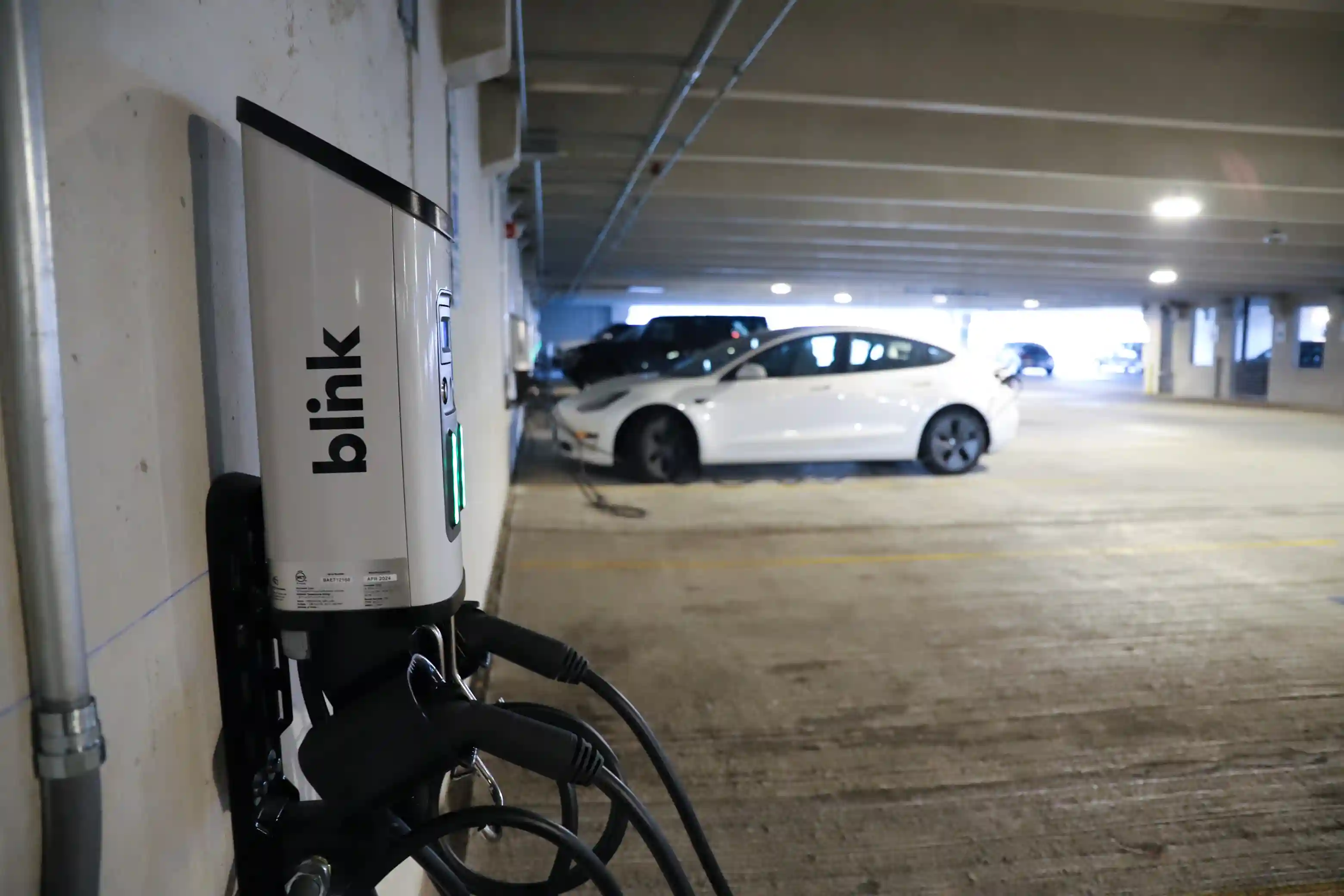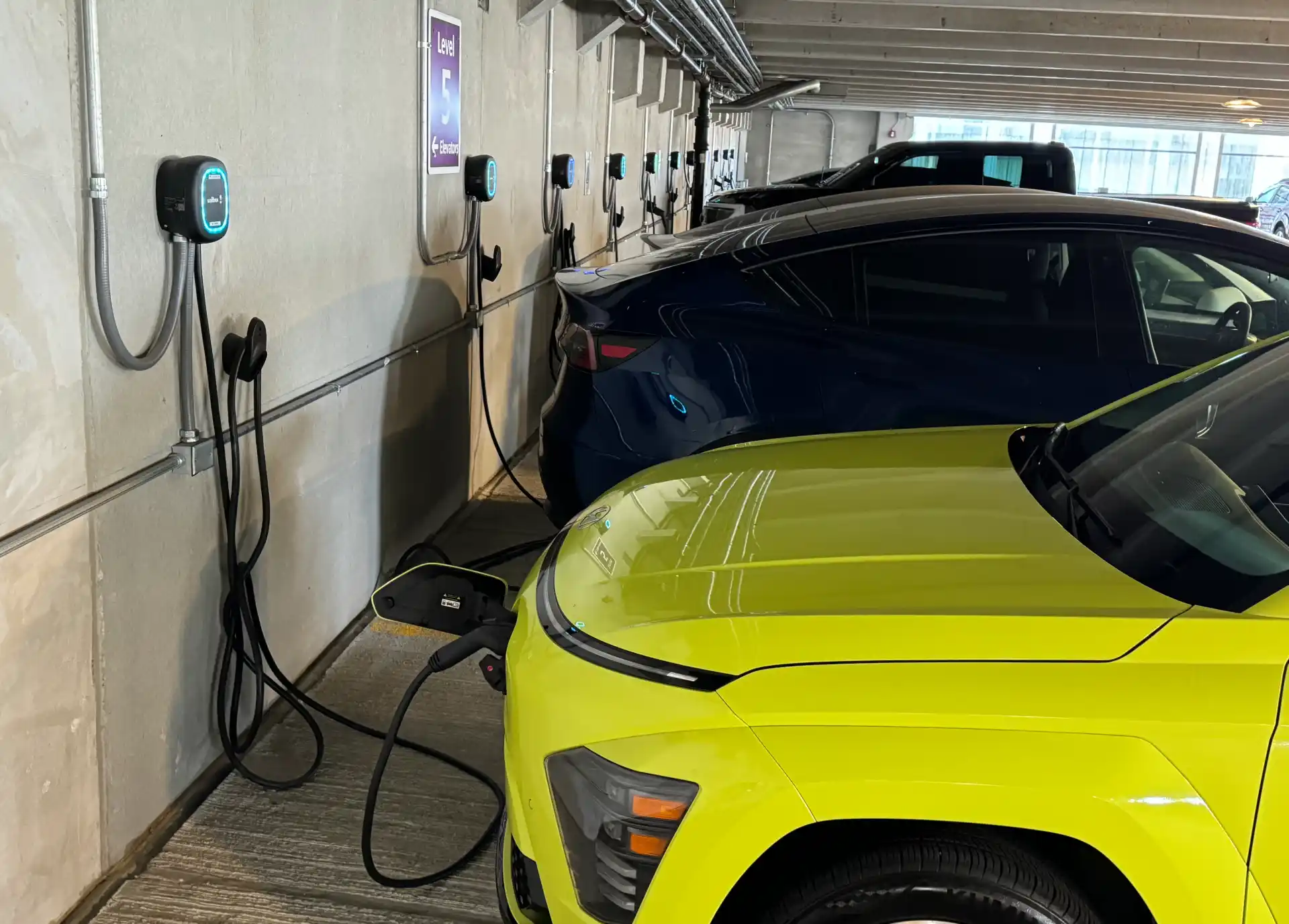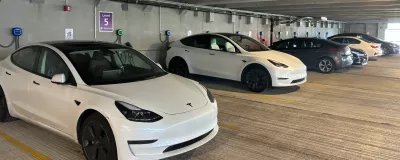To support environmental sustainability, Rush is expanding access to electric vehicle charging for staff members, faculty, students, patients, visitors and the communities we serve.
Rush is creating a master plan for EV charging ports at Rush University Medical Center to allow EV drivers to maximize the number of electric miles driven to and from the campus. This ties directly to our mission of improving community and human health. By providing infrastructure to encourage EV use, Rush is helping reduce pollution from vehicle emissions, which improves local air quality and reduces our collective contributions to climate change.
EV Charging Best Practices
To ensure we can attain our program goals of expanding access to EV charging and maximizing EV miles driven, please follow these best practices while charging at Rush:
- Charge only when you need it. There are hundreds of EVs that visit our campus daily and only 29 charging ports.
- Move your car when it’s fully charged whenever possible so the next vehicle can charge up.
- Holster the connector and hang the cord after use to prevent damage.
- Please provide feedback about our EV charging program. Sharing your feedback and experience will help our EV charging program improve.
Expansion project updates
Rush University Medical Center started with just four EV charging ports available in the main parking garage. Due to high demand, these four ports are nearly always in use, making it difficult to find an available station. To address this and support the growing number of EVs visiting the campus, the Rush Facilities, Capital Projects and Office of Environmental Sustainability (OES) have collaborated with our partners at Resource Innovations to develop a pilot project to expand EV charging options.
The expansion project resulted in the installation of 25 new EV charging ports in the Joan and Paul Rubschlager Building parking garage. Details for these chargers are outlined below.
- Blink EV charging stations
- Location: Second floor, Rubschlager Building parking garage
- Charging type: Level 2 (will add approximately 25-30 miles of range for every hour of charging)
- Connector plug: J-1772
- Number of ports: 12

- Wallbox EV charging stations
- Location: Fifth floor, Rubschlager Building parking garage
- Charging type: Level 1 (will add approximately 5-10 miles of range for every hour of charge)
- Connector plug: J-1772
- Number of ports: 13

From now through December 2024, Rush will provide charging at no cost in exchange for users’ feedback about their charging experience and needs. Beginning in January 2025, we intend to charge a small energy fee (per kilowatt hour) to help sustain EV charging operations over the long term and cover the associated electricity costs. To discourage all-day parking and ensure we can serve as many EV drivers as possible in the faster charger (Blink) spaces, we will also charge begin charging hourly “overstay fees” if vehicles are not moved within 60 minutes of being fully charged, also starting in January 2025. This will ensure we can serve as many drivers as possible and maximize electric miles driven.

Please provide your feedback from now through December so our team can make decisions about future EV charging program based on your experience with this pilot.
How to use our chargers
Blink: Second floor of the Rubschlager Building parking garage
- Download the Blink app (Apple App Store or Google Play) and log in to your account. Or you can charge as a guest by entering your billing data directly in the app
- Blink indicator lights inform you as follows:
- Green – ready to charge
- Blinking blue – actively charging
- Steady blue – charging complete
- Red – charger issue/malfunction
- Select the charger you’re planning to use in the app
- Pricing is displayed directly on the charging unit and in the app
- The charger will flash green
- Plug in to start the charge
- The charger’s light will turn blue to indicate the charge has begun
For more support, visit Blink’s FAQ page.
Wallbox: Fifth floor of the Rubschlager Building parking garage
- Download the Wallbox app (Apple App Store or Google Play) and log in with Google, Apple, or other email
- Wallbox indicator lights inform you as follows:
- Green – ready to charge
- Dark blue – actively charging
- Light blue – charging complete
- Red – charger issue/malfunction
- Charging will begin automatically when you plug in the EV connector, but you can use the Wallbox app to pause or resume charging and to see statistics about your charge at any point
For more support, visit Wallbox’s FAQ page.
ChargePoint: First floor of the main parking garage (Paulina/Harrison)
- Download the ChargePoint app (Apple App Store or Google Play) and log in or sign up
- Tap your phone on the RFID reader on the charging pedestal
- The charging cord will release
- Plug in to charge
To learn more, visit the ChargePoint FAQ page.
FAQ
Rush has a goal to maximize the number of EV miles driven by those bringing EVs to our campus. The installation of these new chargers is the first phase in developing a strategy that meets the ever-changing needs of EV drivers who come to Rush, and supports Rush's ambitious sustainability goals.
The installation of this amenity was funded in part by rebates from the ComEd Make-Ready Rebate Program, Rush Facilities and our Environmental Sustainability team.
As part of its study, Rush is weighing all options when it comes to which charging policy is best. However, electricity is not free, and Rush is designing a fee schedule that is the most equitable toward our entire community.
The primary difference is the speed at which your vehicle charges. Level 1 chargers are the slowest and are sometimes referred to as “trickle chargers” as they only add around 5 to10 miles of range for every hour you charge. Level 2 chargers are faster and can add 25 to 30 miles of range for every hour you charge. Though Rush does not currently have Level 3 chargers onsite (also known as DC fast chargers), they are very powerful and can fill an empty battery in well under an hour. (“Full” typically is considered to be about 80% charged, to protect the battery.)
Please fill out this form and select whether you’d like to report an issue with one of our chargers or provide feedback about your experience using one.
Vehicles that remain connected to a charging station after a full charge has been reached may be charged an overstay fee (also sometimes referred to as an “idle fee”). This is being done to encourage drivers to move their cars in a timely manner, allowing other drivers to access the chargers. Overstay fees can promote efficient charging and shorten wait times. At Rush, these fees begin one hour after a full charge is complete and are applicable only to the Blink chargers on the second floor of the Rubschlager Building garage during the pilot/feedback period.
Rush worked with a consulting team to identify the best vendors for this pilot effort and weighted numerous variables before settling on Blink for the Level 2 chargers, such as its reputation with health care facilities, cost, maintenance and operational needs, commitment to sustainability, U.S. manufacturing location and more. Wallbox was selected for the Level 1 chargers because of their reputation, lower upfront and ongoing operational costs and ability to power share between chargers.
This is normal as the chargers are connected so they can power share when there are multiple cars plugged in. You will notice faster charging speeds (close to Level 2) when fewer cars are plugged in to the Wallbox chargers, but slightly slower (Level 1) speeds when multiple cars are plugged in as they share the power between the chargers.
The garage adjoining the state-of-the-art Joan and Paul Rubschlager Building was built to have the capacity and infrastructure for EV charging. Retrofitting other parking facilities across campus would be more costly and take more time. However, the EV charging master plan aims to look at the feasibility of expanding EV charging elsewhere.
Absolutely! You do not need to be a staff member or visitor to the Rush campus to use these chargers. Although there is a fee to access the Rubschlager Building garage, one of the goals of this project is to broaden EV charging access across the Illinois Medical District and the West Side. Future phases of the master plan will bring additional options and access for EV charging.

